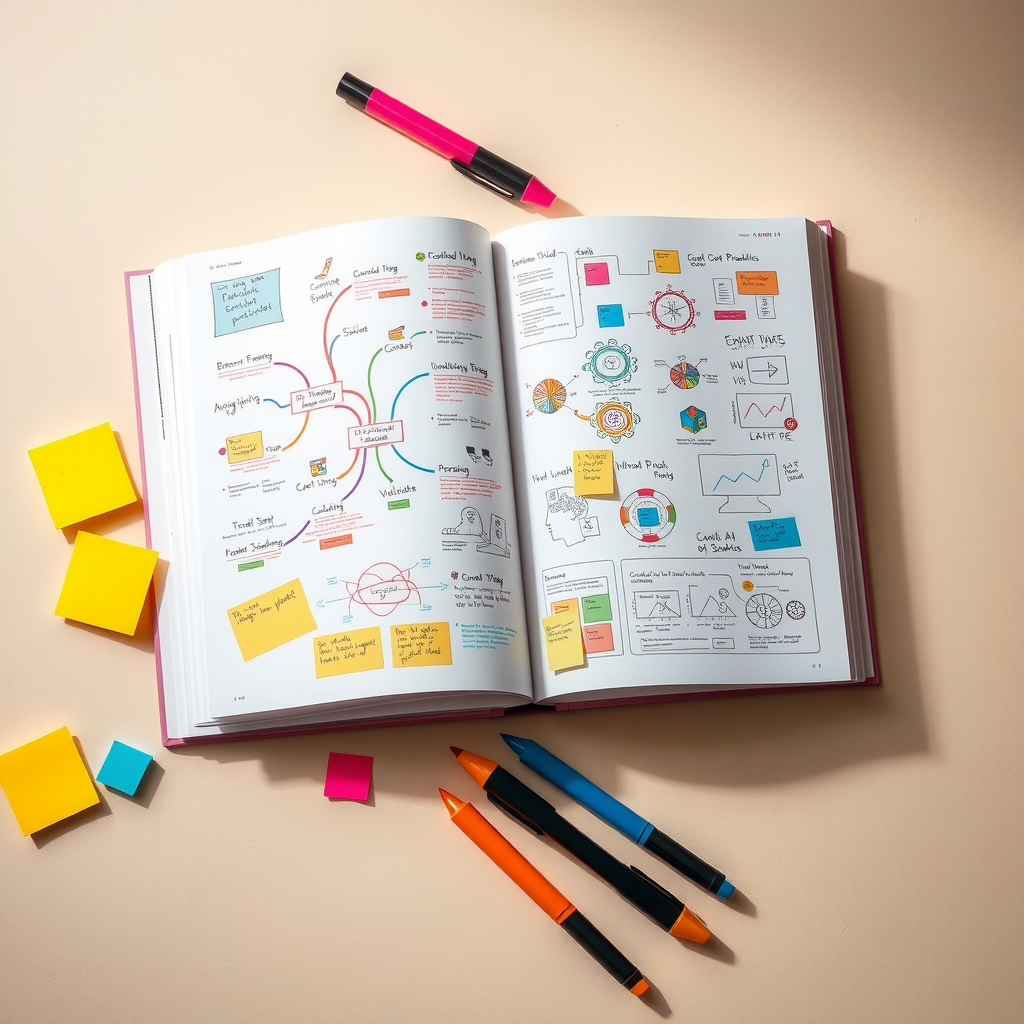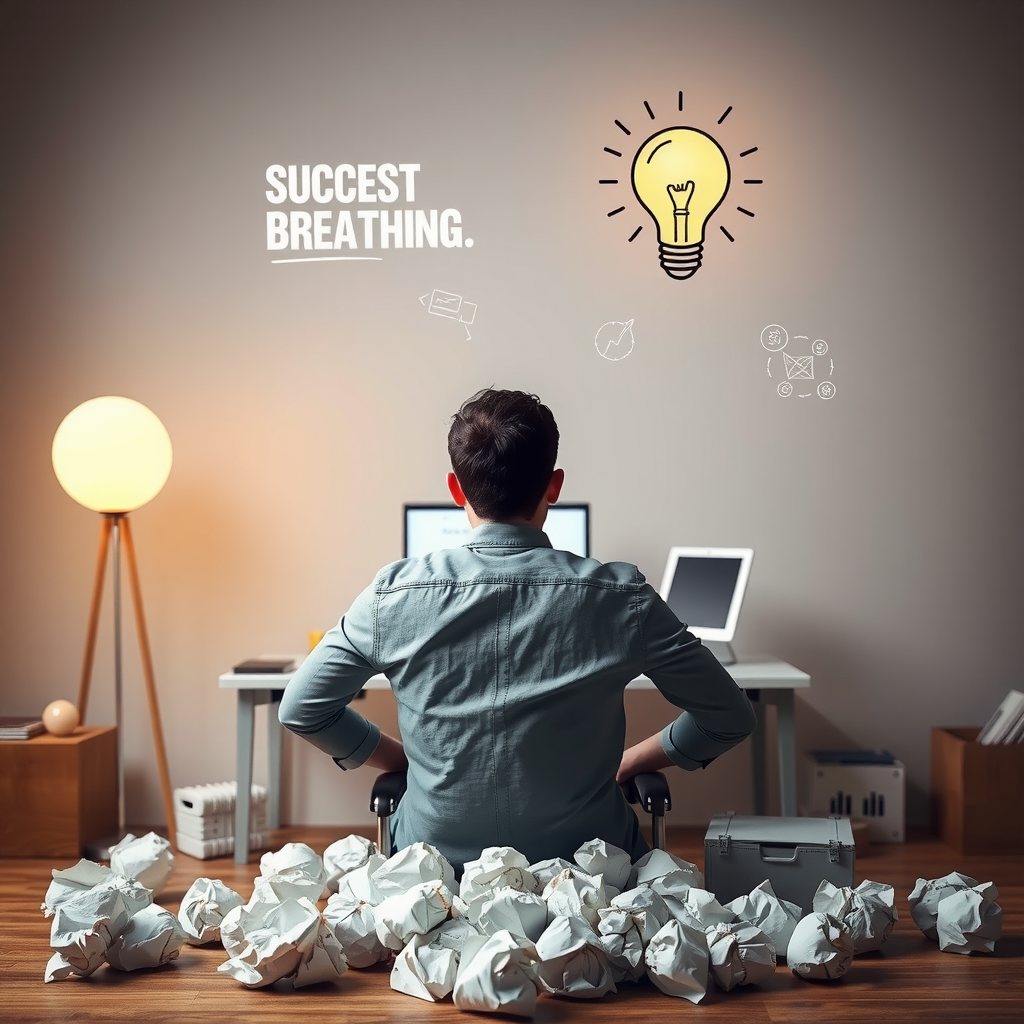Creative Thinking: Books to Unlock Your Innovative Potential
Published on November 3, 2024

In a world that increasingly values innovation and original thinking, the ability to think creatively has become one of the most sought-after skills. Whether you're an entrepreneur seeking breakthrough ideas, an artist looking to overcome creative blocks, or a professional aiming to solve complex problems in novel ways, the right book can serve as a catalyst for transformative thinking.
Creative thinking isn't just an innate talent reserved for a select few—it's a skill that can be developed, refined, and strengthened through deliberate practice and exposure to diverse perspectives. The books we've carefully selected represent a comprehensive guide to unlocking your innovative potential, drawing from psychology, neuroscience, business strategy, and artistic practice.
Understanding the Creative Mind
Before diving into specific techniques and exercises, it's essential to understand how creativity actually works. Modern neuroscience has revealed fascinating insights about the creative process, showing that innovation often emerges from the intersection of different knowledge domains and the ability to make unexpected connections.
"Creativity is just connecting things. When you ask creative people how they did something, they feel a little guilty because they didn't really do it, they just saw something. It seemed obvious to them after a while."
— Steve Jobs
The books in this collection approach creativity from multiple angles, ensuring you develop a well-rounded understanding of how to generate, evaluate, and implement innovative ideas. From practical exercises to theoretical frameworks, these resources provide both the inspiration and the tools needed to enhance your creative capabilities.
Essential Books for Creative Breakthrough

1. "Thinking, Fast and Slow" by Daniel Kahneman
Nobel laureate Daniel Kahneman's groundbreaking work explores the two systems that drive the way we think: the fast, intuitive system and the slow, deliberate one. Understanding these cognitive processes is fundamental to creative thinking, as innovation often requires knowing when to trust your intuition and when to engage in careful analysis. This book provides invaluable insights into decision-making, bias recognition, and the mental frameworks that either enhance or inhibit creative thought.
Kahneman's research demonstrates how our minds can be both our greatest asset and our biggest obstacle in creative endeavors. By learning to recognize cognitive biases and mental shortcuts, you can develop strategies to overcome them and approach problems with fresh perspectives. The book is particularly valuable for professionals who need to make innovative decisions under uncertainty.
2. "The Artist's Way" by Julia Cameron
Julia Cameron's transformative twelve-week program has helped millions of people recover their creative selves. Through practical exercises like "Morning Pages" and "Artist Dates," this book guides readers through a systematic process of unblocking creativity and reconnecting with their artistic impulses. While originally designed for artists, the techniques are universally applicable to anyone seeking to enhance their creative thinking.
What makes this book particularly powerful is its emphasis on the spiritual and emotional aspects of creativity. Cameron addresses the fears, doubts, and limiting beliefs that often prevent people from fully expressing their creative potential. The structured approach provides a clear path forward, making it easier to develop consistent creative habits that lead to breakthrough thinking.
3. "Creative Confidence" by Tom and David Kelley
The Kelley brothers, founders of the renowned design firm IDEO, share their insights on building creative confidence through design thinking principles. This book demonstrates that creativity isn't about artistic talent—it's about having the confidence to try new things, learn from failure, and persist in the face of challenges. The authors provide numerous real-world examples and practical exercises that help readers develop their creative muscles.
The book's emphasis on "design thinking" as a methodology for innovation has revolutionized how organizations approach problem-solving. By focusing on empathy, experimentation, and iteration, the Kelleys show how anyone can develop the mindset and skills needed to generate innovative solutions. This approach is particularly valuable for business professionals and entrepreneurs looking to foster innovation within their organizations.

4. "Lateral Thinking" by Edward de Bono
Edward de Bono's concept of lateral thinking has become a cornerstone of creative problem-solving methodology. Unlike traditional logical thinking, which moves forward step by step, lateral thinking involves approaching problems from unexpected angles and making deliberate leaps in reasoning. This book introduces practical techniques for breaking out of established patterns and generating truly original ideas.
De Bono's methods, including the famous "Six Thinking Hats" technique, provide structured approaches to creative thinking that can be applied in both individual and group settings. The book is filled with exercises and examples that demonstrate how to challenge assumptions, reframe problems, and discover innovative solutions that might otherwise remain hidden. It's an essential resource for anyone serious about developing their creative thinking capabilities.
5. "Steal Like an Artist" by Austin Kleon
Austin Kleon's refreshingly honest and practical guide challenges the myth of completely original creation. Through ten transformative principles, Kleon shows how all creative work builds on what came before and how embracing influence can actually enhance rather than diminish originality. The book's accessible style and visual presentation make complex creative concepts easy to understand and apply.
What sets this book apart is its emphasis on the creative process as a journey of discovery and remix rather than pure invention. Kleon encourages readers to collect ideas, keep a "swipe file," and learn from the masters while developing their own unique voice. This approach is particularly liberating for those who feel paralyzed by the pressure to be completely original, showing that creativity is more about connection and transformation than creation from nothing.
Practical Techniques from Creative Masters
Beyond individual books, the collective wisdom of these authors reveals several universal principles for enhancing creative thinking. First, creativity requires both divergent thinking (generating many possibilities) and convergent thinking (selecting and refining the best ideas). The most innovative thinkers know when to use each mode and how to transition between them effectively.
Key Techniques to Practice:
- Mind Mapping:Visualize connections between ideas to discover unexpected relationships and patterns.
- Constraint-Based Thinking:Use limitations as creative catalysts rather than obstacles.
- Cross-Pollination:Deliberately expose yourself to diverse fields and perspectives to spark new ideas.
- Incubation Periods:Allow time for subconscious processing between active problem-solving sessions.
- Rapid Prototyping:Test ideas quickly and learn from failure without excessive planning.
Second, environment plays a crucial role in creative thinking. The books emphasize the importance of creating physical and mental spaces that support innovation—whether that's a dedicated workspace, regular time for reflection, or a community of fellow creative thinkers who can provide feedback and encouragement.
Overcoming Creative Blocks

One of the most valuable aspects of these books is their practical guidance on overcoming creative blocks. Every creative person encounters periods of stagnation, self-doubt, or mental exhaustion. The authors provide evidence-based strategies for working through these challenges, from changing your environment to adjusting your expectations about the creative process.
A common theme across these works is the importance of embracing failure as a necessary part of innovation. Creative breakthroughs rarely emerge from the first attempt; they result from persistent experimentation, learning from mistakes, and refining ideas through multiple iterations. By reframing failure as feedback rather than defeat, you can maintain the resilience needed for sustained creative work.
The books also address the psychological barriers to creativity, including perfectionism, fear of judgment, and imposter syndrome. Understanding these internal obstacles is often the first step toward overcoming them. The authors provide compassionate yet practical advice for developing the mental fortitude required to pursue innovative ideas despite uncertainty and criticism.
Building a Creative Practice
Perhaps the most important insight from these books is that creativity isn't about waiting for inspiration to strike—it's about developing consistent practices that make innovation more likely. Just as athletes train their bodies through regular exercise, creative thinkers must train their minds through deliberate practice and exposure to new experiences.
The authors recommend establishing daily or weekly creative rituals that become habitual. This might include morning journaling, regular brainstorming sessions, dedicated time for reading and learning, or structured exercises in creative problem-solving. The key is consistency rather than intensity; small, regular investments in creative practice compound over time to produce significant results.
Start Your Creative Journey Today
Choose one book from this collection and commit to reading it actively—taking notes, completing exercises, and applying the concepts to your own challenges. Your innovative potential is waiting to be unlocked.
Applying Creative Thinking in Different Domains
While these books provide universal principles for creative thinking, their application varies across different fields. In business, creative thinking might manifest as innovative product development or novel marketing strategies. In the arts, it could mean developing a unique style or exploring new mediums. In science and technology, creativity drives breakthrough discoveries and inventions.
The beauty of the books in this collection is their versatility. Whether you're a software developer looking to design more elegant solutions, a teacher seeking engaging ways to present material, or a writer working to craft compelling narratives, the principles and techniques described in these works can be adapted to your specific context and goals.
Moreover, creative thinking isn't limited to professional pursuits. These books can help you approach personal challenges with greater imagination, find innovative solutions to everyday problems, and live a more fulfilling life by expressing your unique perspective and talents. Creativity is fundamentally about seeing possibilities where others see limitations and having the courage to pursue those possibilities.
The Neuroscience of Creativity
Recent advances in neuroscience have provided fascinating insights into the biological basis of creativity. Brain imaging studies show that creative thinking involves complex interactions between different neural networks, including those responsible for focused attention, spontaneous thought, and cognitive control. Understanding these mechanisms can help you optimize your creative process.
Several of the recommended books incorporate these scientific findings, explaining how factors like sleep, exercise, and mental state affect creative performance. For instance, research shows that mild positive moods tend to enhance creative thinking, while high-pressure situations often inhibit it. Similarly, allowing your mind to wander during breaks can facilitate the unconscious processing that leads to creative insights.
The books also discuss the importance of neuroplasticity—the brain's ability to form new connections and adapt throughout life. This means that creative thinking skills can be developed at any age through consistent practice and exposure to novel experiences. The key is to challenge yourself regularly with new problems, perspectives, and domains of knowledge.
Collaborative Creativity

While much of creative thinking happens individually, collaboration can amplify innovative potential exponentially. The books in this collection emphasize the value of diverse perspectives and the creative friction that emerges when different viewpoints collide. Learning to harness collective creativity is essential in today's interconnected world.
Effective creative collaboration requires specific skills: active listening, building on others' ideas, suspending judgment during brainstorming, and creating psychological safety where team members feel comfortable sharing unconventional thoughts. The authors provide frameworks for facilitating productive creative sessions and avoiding common pitfalls like groupthink or premature criticism.
Additionally, the books discuss how to balance individual creative work with collaborative efforts. Some phases of the creative process benefit from solitary reflection and deep focus, while others thrive on group interaction and diverse input. Understanding when to work alone and when to seek collaboration is a crucial skill for maximizing creative output.
Sustaining Creative Momentum
One of the greatest challenges in creative work is maintaining momentum over time. Initial enthusiasm often fades when faced with obstacles, setbacks, or the mundane aspects of bringing ideas to fruition. The books address this reality by providing strategies for sustaining creative energy and motivation through long-term projects.
Key strategies include breaking large creative projects into smaller milestones, celebrating incremental progress, maintaining a portfolio of diverse projects at different stages, and building supportive communities that provide encouragement and accountability. The authors also emphasize the importance of self-care, recognizing that creative work requires mental and emotional resources that must be replenished regularly.
Furthermore, the books discuss how to navigate the inevitable periods of doubt and frustration that accompany creative work. Rather than viewing these as signs of failure, the authors frame them as natural parts of the creative cycle. Learning to persist through difficult phases while remaining open to pivoting when necessary is essential for long-term creative success.
Measuring Creative Growth
Unlike many skills where progress is easily quantifiable, creative development can seem nebulous and difficult to measure. However, the books provide frameworks for assessing your creative growth over time. This might include tracking the quantity and quality of ideas generated, monitoring your ability to overcome creative blocks, or evaluating the originality and impact of your creative output.
More importantly, the authors encourage readers to develop their own metrics for creative success that align with personal values and goals. For some, creative growth might mean producing more work; for others, it might mean taking bigger creative risks or developing a more distinctive voice. The key is to establish clear intentions and regularly reflect on your progress toward them.
The books also emphasize that creative development isn't linear. There will be periods of rapid growth and times of apparent stagnation. Understanding this natural rhythm helps maintain perspective and prevents discouragement during slower phases. Often, what seems like stagnation is actually a period of consolidation and integration that precedes the next creative leap.
Your Creative Journey Begins Now
The books featured in this collection represent decades of research, practice, and insight from some of the world's leading experts on creativity and innovation. Each offers a unique perspective and set of tools for unlocking your creative potential. Whether you're just beginning to explore your creative capabilities or seeking to deepen an established practice, these resources provide invaluable guidance.
Remember that reading about creativity is just the first step—the real transformation happens through application and practice. As you explore these books, commit to implementing the techniques and exercises they describe. Start small, be patient with yourself, and trust the process. Creative thinking is a skill that develops over time through consistent effort and genuine curiosity.
The world needs your unique creative contributions. By investing in your creative development through these carefully selected books, you're not only enhancing your own capabilities but also preparing to make meaningful contributions to your field, your community, and the broader culture. Your innovative potential is vast—these books will help you unlock it, one page at a time.
"The creative adult is the child who survived."
— Ursula K. Le Guin